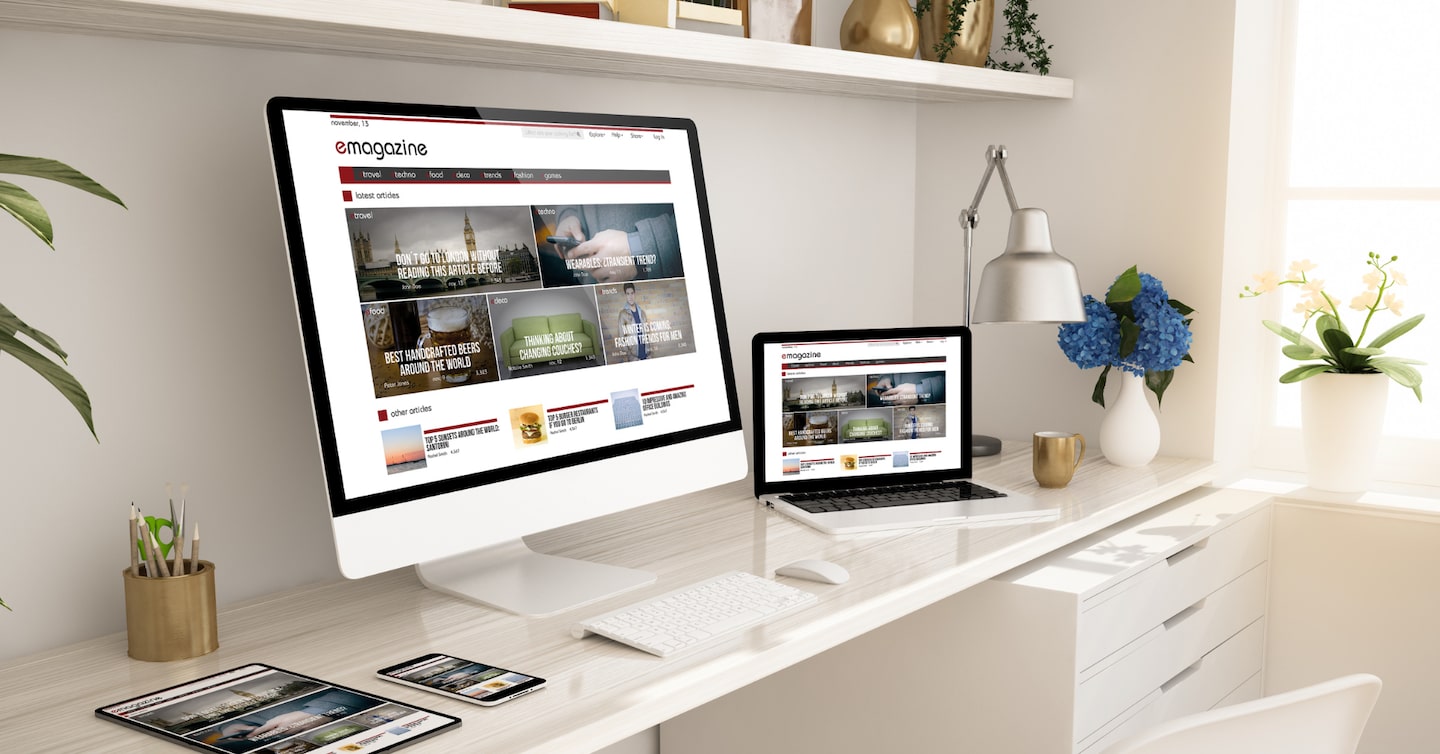7 Strategies to Improve UX for News and Broadcast Websites

User experience (UX) plays a critical role in how audiences interact with news and broadcast media websites. A seamless, engaging, and personalized experience not only keeps users coming back but also builds trust and loyalty. For media organizations, a strong UX is directly tied to audience retention, subscription growth, and ad revenue. In a digital era, where audiences have many ways to consume media, failing to prioritize UX means missing critical opportunities to capture and retain engagement.
Poor UX can have a subtle, yet significant impact on the user experience, often in ways that go unnoticed at first. When users land on a site that isn’t intuitive, or when they encounter slow load times, cluttered layouts, or confusing navigation, they can quickly lose interest. These issues can create friction in the user’s journey—whether it’s taking too long to find content or struggling to interact with the site—and cause them to abandon the experience altogether. The consequences of this are often seen in high bounce rates, reduced time on site, and lost opportunities to convert casual readers into loyal subscribers. Even when users are familiar with a brand, poor UX can still lead to a loss of trust and engagement if the content isn’t delivered in a way that meets expectations.
Modern audiences demand fast-loading pages, intuitive navigation, and content tailored to their preferences. They value interactive, high-quality storytelling regardless of their preferred device. Media companies that fail to meet these expectations face the consequences of decreased audience engagement. An initial glance might be enough for a user to decide “Eh, I’ll check this out later,” or worse, decide that the experience isn’t worth their time at all, even when they are familiar with the brand. By focusing on UX, news and broadcast websites can differentiate themselves, foster deeper connections with readers, and secure their place in an increasingly crowded digital marketplace.
Here are seven essential strategies to improve UX on your platform.
1. Focus on Content Presentation and Design
A visually appealing and accessible website isn’t just a nice-to-have—it’s essential. Accessibility ensures your platform welcomes all users, including those with disabilities. By integrating features such as alt text for images, keyboard-friendly navigation, high-contrast color schemes, and other Web Content Accessibility Guidelines (WCAG) standards, you can provide an inclusive experience for everyone while broadening your reach.
Beyond accessibility, strong design principles amplify your content’s impact and contribute to better SEO outcomes. Clean, responsive layouts ensure your site adapts seamlessly to desktops, tablets, and smartphones. This means headlines resize elegantly, images load correctly, and navigation stays intuitive on any device. Search engines reward such usability with improved rankings, making good design an asset for both audience engagement and discoverability. Thoughtful, uncluttered designs that emphasize key content invite readers in and keep them engaged, ensuring a memorable experience across platforms.
2. Simplify Navigation and Enhance Content Discovery
Navigation should guide users effortlessly to the content they seek, reducing frustration and increasing satisfaction. Organize your site into clear categories and use labels that resonate with your audience. With Arc XP’s partnership with Queryly, users can experience faster, more intuitive content discovery. Queryly integrates Google- and Bing-level search capabilities into your site, offering a powerful cloud platform that deeply understands your content. This results in quicker, more relevant search experiences and personalized recommendations, such as trending articles and tailored suggestions based on user behavior. By aligning search functionality with user intent, Queryly boosts engagement and keeps readers coming back.
Metadata is another crucial tool for enhancing user interactions. Use sections, tags, headlines, subheadlines, and clickable author bylines to streamline content discovery. Tagging articles by topics or themes not only helps readers find related stories but also strengthens internal linking, increasing time spent on your site and boosting SEO. Detailed metadata enables advanced personalization, such as topic-specific newsletters and tailored recommendations that align with individual preferences. By analyzing user behavior regularly, you can identify patterns and refine navigation paths to ensure a seamless and engaging user experience.
3. Maintain Consistency Across Platforms
In today’s multi-device world, users expect a seamless and cohesive experience whether they’re on a smartphone, tablet, or desktop. Meeting this expectation requires adopting responsive design principles and standardizing visual elements across all platforms. Think of it as creating a digital handshake—familiar and reliable every time.
Ensure that fonts, buttons, and branding elements function seamlessly across all devices, maintaining familiar patterns that adapt appropriately to mobile and desktop experiences. Regularly test your site on various browsers and screen sizes to catch and address any inconsistencies. By delivering a uniform experience, you not only build trust but also strengthen your brand identity, encouraging users to return and engage more deeply with your content.
4. Implement Personalization Features
To start, use recommendation engines powered by AI to suggest articles or videos based on user behavior. For instance, if a user frequently reads stories about climate change, related content can be surfaced prominently on their homepage or within their recommended reading list. These tools can also identify emerging patterns to build dynamic audience segments, allowing you to introduce users to new types of content and broaden their discovery journey.
Make engagement more seamless by introducing features like saved stories and tailored notifications. These allow users to bookmark articles for future reading or receive alerts when new content on their favorite topics is published. By integrating first-party data, you can refine these personalized experiences further while adhering to privacy standards. This ensures that your audience feels understood and valued, fostering long-term loyalty and deeper engagement with your content.
5. Encourage Engagement and Interactivity
Interactive elements aren’t just attention-grabbers; they’re a gateway to meaningful audience connections. Features like live stories offer real-time updates on breaking news, keeping users informed and engaged as events unfold. Incorporating multimedia elements—such as videos, animations, and infographics—enhances storytelling by making content more dynamic and immersive.
Polls, quizzes, and gamification can also transform passive readers into active participants. For example, a trending poll about a major news event or a quiz tied to your content invites your audience to join the conversation. These features not only extend the time users spend on your platform but also create a sense of community and satisfaction, driving deeper loyalty.
6. Prioritize High-Quality Content
Great content is at the heart of any successful user experience. Take the time to ensure your articles are well-researched, accurate, and transparent. Always credit your sources, correct any mistakes quickly, and provide proper attributions where needed.
Building trust with your readers is all about staying true to your editorial values. Be clear about sponsored content, and steer clear of sensational clickbait headlines. Readers appreciate honesty and authenticity, and by sticking to these principles, you’ll earn their trust and build a reputation as a reliable, credible source of news.
7. Optimize Performance and SEO
The performance of your website plays a huge role in keeping users happy and improving your search rankings. Start with optimizing page speed—this means cutting out unnecessary JavaScript and CSS, enabling caching, and resizing images so they load faster. For videos, using adaptive streaming will ensure high-quality visuals without slowing things down.
When it comes to SEO, you want to make sure search engines can easily crawl your site. To do this, include files like sitemap.xml and robots.txt, which guide search engines on how to index your content. A clean, well-organized site structure and mobile-friendly design are essential for getting noticed in search results. And don’t forget to regularly check your analytics to spot any performance issues so you can fix them quickly. By keeping an eye on these elements, you’re setting your site up for better user experiences and higher visibility online.
Improving the UX of your news and broadcast website isn’t just about creating a sleek interface—it’s about building a deeper connection with your audience. By addressing friction points in UX and adopting these strategies, you’re not only improving your site but also investing in the future of your audience’s experience, making them feel valued and keeping them coming back for more.
Recent resources




